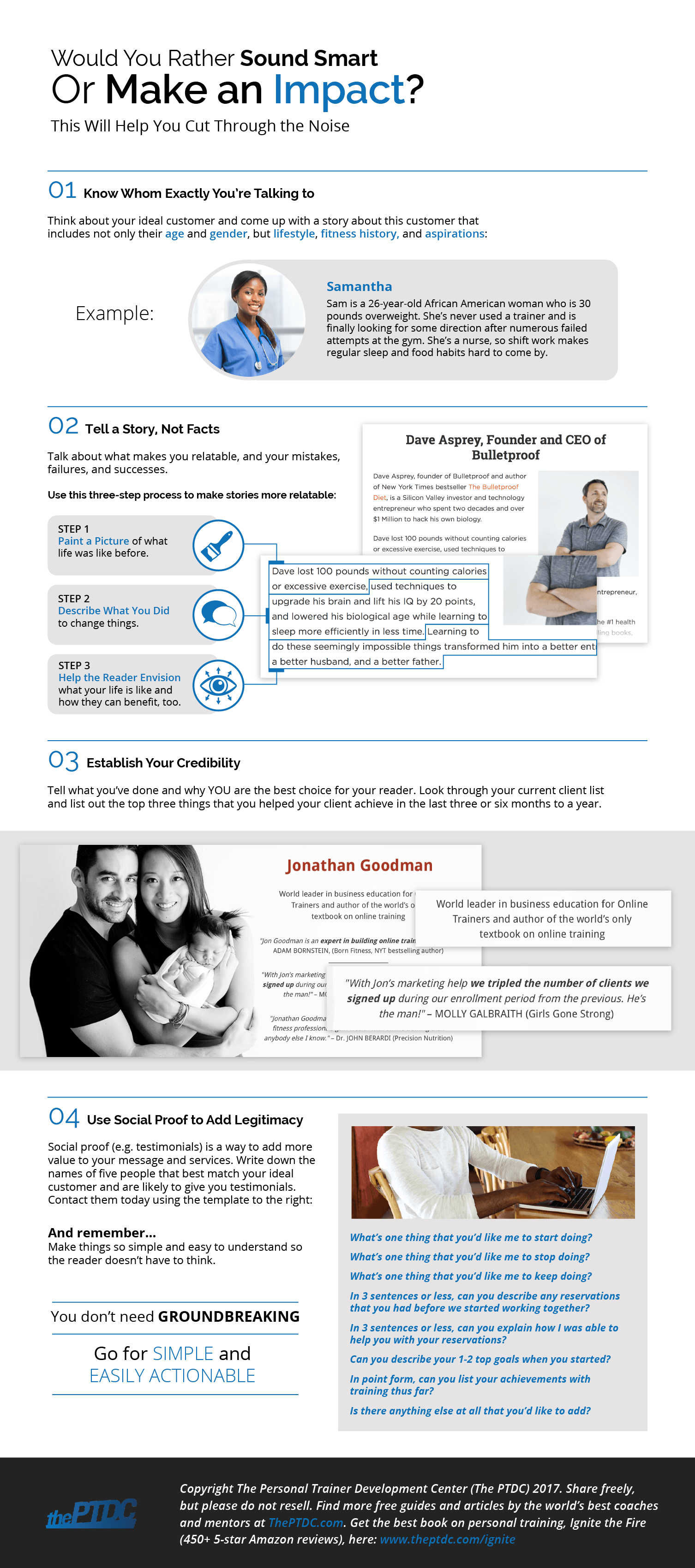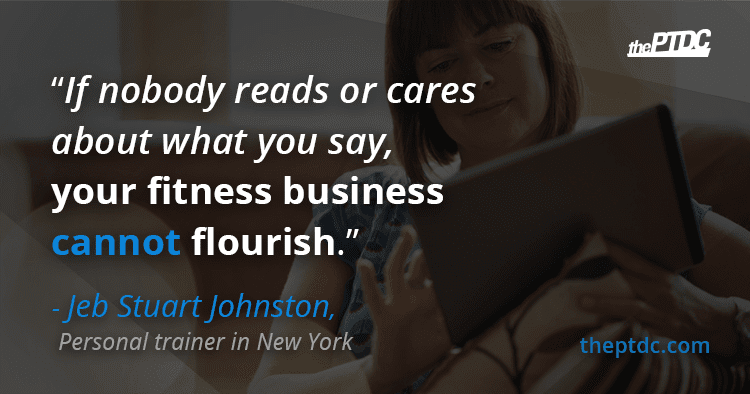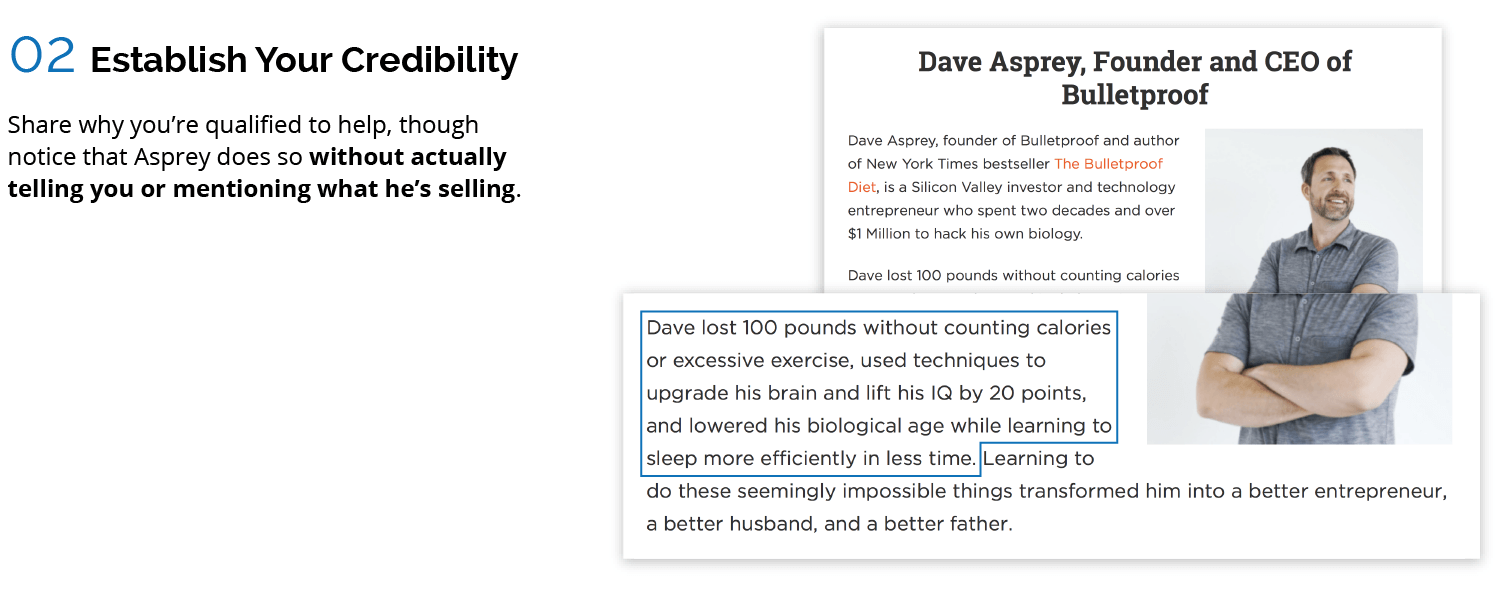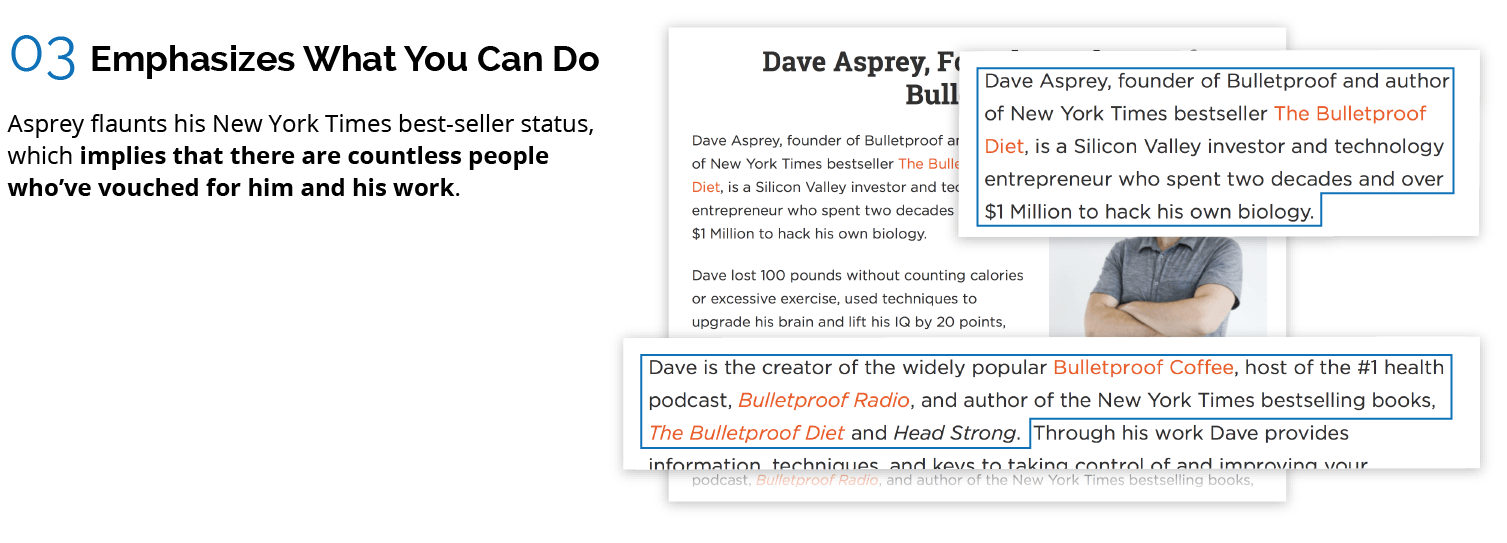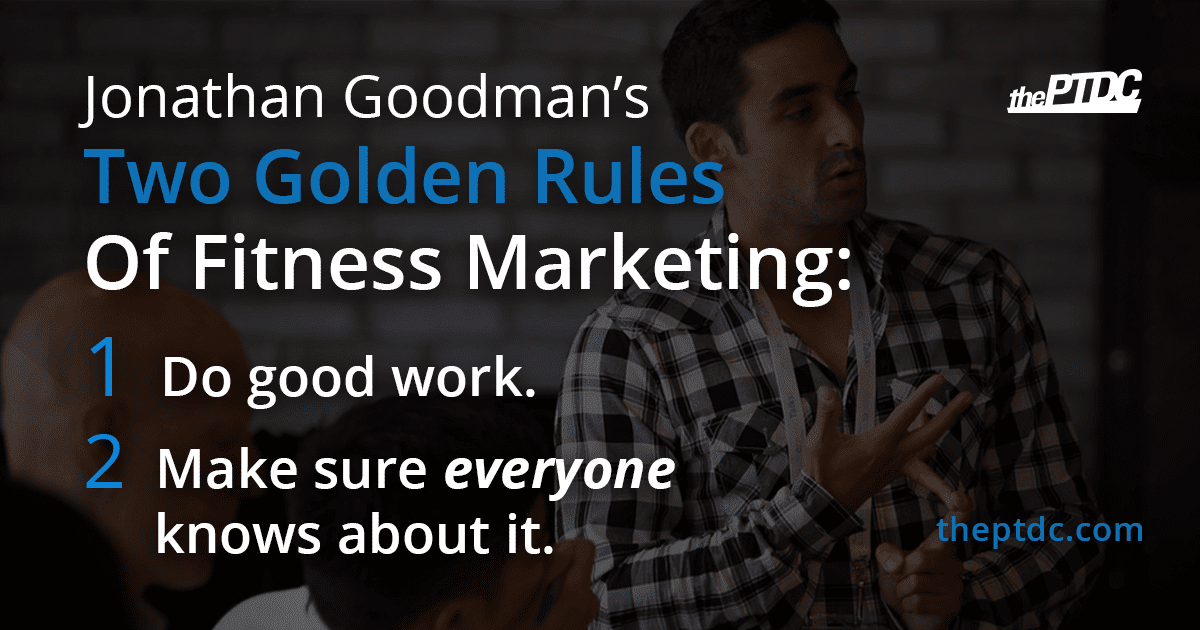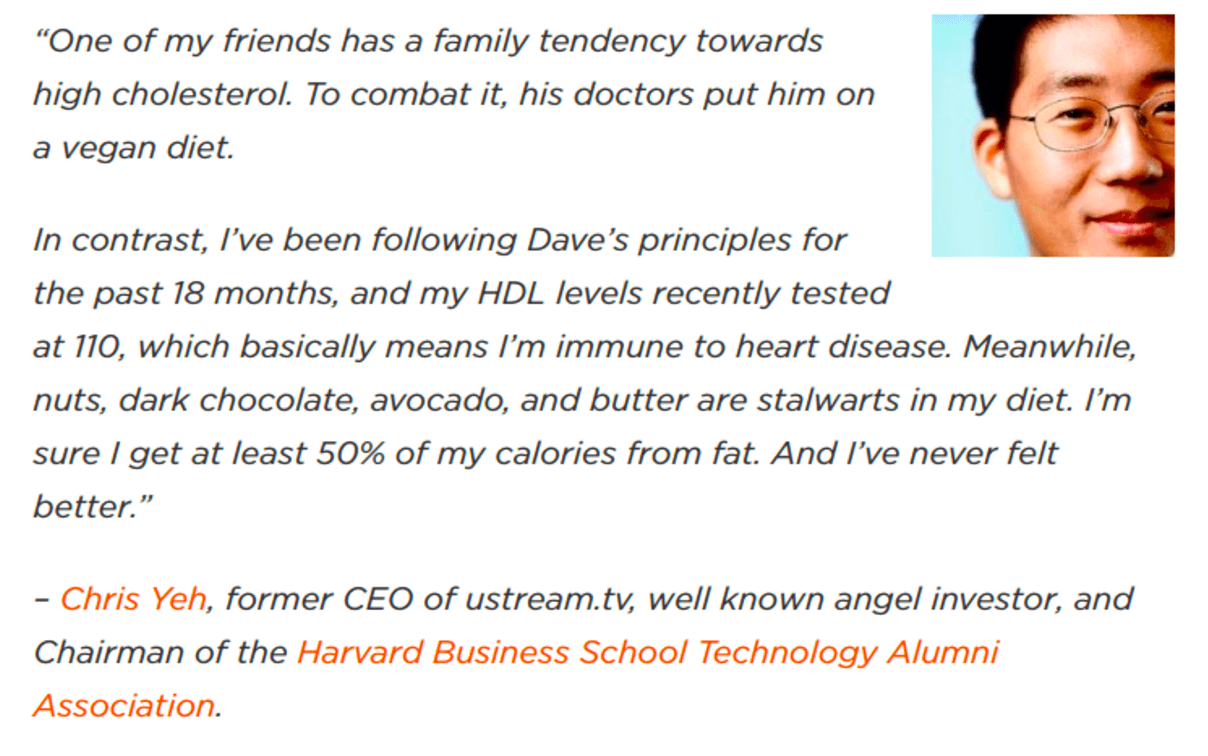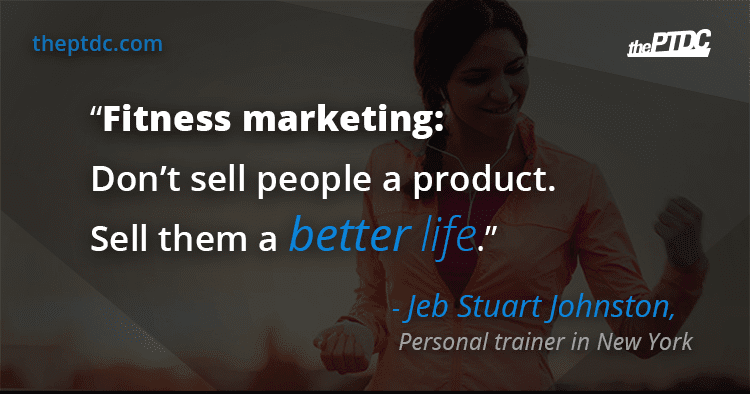If you’re frustrated that others seem to be getting more attention and clients, the problem probably isn’t your information -- it’s your delivery.
In Seth Godin’s book, The Power of Telling Authentic Stories in a Low-Trust World, he explains that readers and potential clients already hold a certain worldview and perspective before encountering you and your information. Your aim is to frame a story within their worldview that they can buy into and, in turn, become believers.
This is easy to say, hard to do, and even harder to do well.
Rather than laying out strategy after strategy, let’s examine one of the most polarizing and financially successful figures in our business and tease out what he does well. In this article, I’ll take a look at how Dave Asprey, founder of Bulletproof, can convince his followers to add gobs of butter in their coffee and believe it’s the greatest thing since sliced bread, all the while building an empire worth millions. You’ll learn:
- The key strategy that smart marketers focus on to make their message impact more people.
- Who your About page is actually for (hint: it’s not about you).
- How a complete stranger can influence a buying decision more than you alone.
- The two things that will make your service and products irresistible.
First, if you’re not familiar with Dave Asprey, let’s catch you up.
Asprey is a computer-guy-turned-Silicon-Valley-bizillionaire-turned-biohacker. A biohacker is someone who has a keen interest in “do it yourself” biology. Many science-minded fitness professionals love to hate on what Asprey conveys, claiming that it is too often a load of unsubstantiated pseudoscience and crockery. Regardless of whose side you’re on, you’d be wise to remove your personal biases and take notes on how he, like Dr. Oz and Food Babe, commands millions of loyal followers.
To Read After: 3 Lessons Fit Pros Can Learn From Dr. Oz and Food Babe (https://www.theptdc.com/2016/11/3-lessons-dr-oz-and-food-babe/)
Here are the five key things you can learn from.
1. Communicate Through Stories
“Storytelling and marketing go hand-in-hand. Just think about it. Whether you’re producing infographics, writing copy for a Facebook ad, or writing a free online guide, you need to capture your audience’s attention.” - Neil Patel and Ritika Puri of Quicksprout
In a Fast Company article, Rachel Gillet wrote that our “brains are far more engaged by storytelling than the cold, hard facts.” It makes sense.
We all know the story of the tortoise and the hare because many of us have felt that hubris of rushing into things, confident that we know more than we really do, and have things blow up in our face when we sit on our laurels. It's a memorable and crucial life lesson masquerading as a children's story.
Simply, it’s easier for us to remember stories because we can imagine and fortify them with our personal experiences and perspectives. When you’re weaving a story, you’re connecting with the reader.
As Patel points out, at the end of the day you’re dealing with emotionally-driven humans.
Asprey harnesses the power of storytelling to further Bulletproof’s mission. In the end his story is relatable, human, and memorable. My rendition of his story goes like this:
Asprey had a history of weight problems and was plagued with low energy and digestive issues. Even after seeing hundreds of medical experts, traditional medicine couldn’t quite solve his woes, so he spent a lot more money conducting experiments on himself to find out what could cure him.
His breakthrough moment hit him during a trip in Nepal, where he had spent time with the Sherpa people, an ethnic group from the Himalayas. While climbing a mountain, he fell ill from altitude sickness and was given a tea brewed with yak butter to treat it. The concoction cured his altitude sickness, but it also restored his energy for him to continue his climb.
Throughout his time with the Sherpa people, Asprey had observed that they drank high-calorie cup after high-calorie cup of this stuff, but no one was fat. It led him to question the prevailing wisdom that “fat makes you fat” and figured there must be something different about this combination. When he returned to the States, Asprey recreated this concoction with grassfed butter instead of Yak butter, and with coffee instead of tea. He named it Bulletproof Coffee and claimed that his “new” discovery of butter in coffee helped him not only lose weight, but become more productive, and also cured his digestive ailments.
Thus, his Bulletproof empire was born.
This is the kind of tale that has all the bits of storytelling we crave: his struggles and failures in the pursuit of perfect health, along with millions of dollars spent on “hacking” his health.
Juicy stuff.
Because of this we see Asprey as just another guy with common ailments that conventional medicine and Big Pharma could not help. This made his problems relatable and casted doubt on modern medicine, and in the process, set up his unconventional methods to be the answer.
By him sacrificing his body and money for science, you get to “reap” all of the benefits without any of the work or expense. He gives you the appearance of having committed a selfless act (using his hard earned money to help you, who may not have been able to afford it). What a guy.
You can do the same -- with your ethics in check.
I know you have suffered for your goals. Before you started your career, I know you may have dieted or force-fed yourself, experimented with many things to find what works, trained long hours at times you would rather be sleeping, and spent more time on your feet in a day than most people do in a week.
You’re human, not just a glorified sex machine on Instagram. So act like it: Talk about what makes you relatable. Talk about all of the mistakes you have made. Talk about your failures and successes. Here’s an example:
You wouldn’t know it when you saw me, but I was miserable.
I was a celebrity hairstylist in one of the top salons in NYC. My work was in every magazine in the world and on every runway at fashion week. I hung out with supermodels and movie stars all day. I went home to the coolest neighborhood in Brooklyn every night.
I was 33 years old and killing it.
Yet something was missing.
For all the glitz and glamour, I just wasn’t happy.
I would bury my misery in sh*tty food, forget about my day with too much booze, and then try to absolve my sins by fasting or getting on the treadmill for an hour.
I hated the person I saw in the mirror. No matter how many new “hacks” I tried, I was still stuck. Still that skinny-fat kid too ashamed to take his shirt off at the pool.
Atkins, Zone, Paleo, Keto, Bulletproof.
They all worked great for a few weeks and then it just as quickly fell apart.
Same hamster, new wheel.
I was desperate for change. I was desperate for help. I was desperate for something more from life.
I read all the New York Times best-selling books.
I was told, just like you, that there was some magical properties to these diets that made them work. I was told that these diets were the only way to lose weight.
What I never realized was that these diets were too restrictive. They didn’t allow me to make choices for my well-being. They didn’t give me the tools to enjoy and stick to my guns in the long term.
When I failed at what was supposed to be "foolproof", I'd felt like a failure. If this method was so popular, there must be something wrong with me.
But it wasn’t me.
I just needed to find another way that worked for me. That didn’t deprive me of joy, and was healthy and sustainable and still made me lose weight.
What I found was, the best way begins and ends with you, not some dogmatic approach to sell books.
Fads don’t work.
Gimmicks don’t work.
Butter in coffee doesn’t always work.
Consistent, measurable changes in lifestyle and choices do.
They aren’t necessarily easy, but they don’t have to be complicated.
When I finally realized this, when I was finally able to make the changes that led to real results, my world opened up.
Today I stand up tall.
I smile more.
I eat foods that fuel my workouts and recovery and still enjoy the things I love.
I stopped medicating myself with alcohol and “rewarding” myself with crappy food.
Today I love the man I see in the mirror (so does my wife).
Stop wasting years of your life like I did. Stop the up-and-down, rollercoaster ride of fad diets and gimmicky workouts. Do what works and has worked for hundreds of my clients.
I've been in that pit of despair. Let me help you out of it, too."
This story conveys how you, too, have been fooled by great marketing; wasted money on gimmicks that don’t work; lost opportunities to better your fitness.
After reading this, your readers might feel OK about making mistakes, instead of feeling stupid that they’ve made mistakes. PubMed articles and Facebook tirades telling people are stupid make them feel, well, stupid.
And no one wants to feel stupid.
It’s natural for us to want to bludgeon delusional zealotry with logic and science, but cold facts don’t win any supporters. Stories do.
2. Make Your About Page About What You Can Do for the Reader
About pages are less about you and more about the reader. Every great About page has these elements:
In the example above, Asprey emphasizes “without counting calories or excessive exercise” and the fact that he could “sleep more efficiently in less time.” These speak to busy, time-strapped, and highly ambitious, entrepreneur-type folks, likely with family. His target customer is likely someone who’s tried all sorts of diets and programs (except for the fundamentals that work, of course) and failed.
By the time you create your About page, you should know exactly whom you're talking to, who your ideal customer is, so that when they read your About page they feel as if you're reading their mind.
Asprey lets the reader know that he personally has lost 100 pounds without doing the fussy work of counting calories or doing much exercise -- incredible!
Losing weight without effort is always a great selling point (as long as it’s not a load of crock).
You don’t need to throw fancy certifications and education in people’s faces. The reality is, your customer doesn’t care to distinguish one certification from another. It’s the more subtle things like how much weight you’ve lost (or muscle you’ve gained), or the fact that you’re a best-selling author, or an author of a weight loss book (if you help people lose weight).
Overall, Asprey’s About page expresses what he’s able to do for the reader. More importantly, he isn’t selling his coffee, butter, or MCT oil.
He’s selling the reader a better life, whether that’s in the form of an improved physique, lower stress, a more fruitful career, or more available nights and weekends with family and friends.
Following Asprey’s and Goodman’s example here, start by telling people why you’re worth listening to. As Goodman’s two golden rules famously say:
1. Do good work.
2. Make sure everyone knows about it.
CSCS or ISSN? Who cares!
People want to know how what you’ve accomplished can help them. Did you help 100 people lose a combined total of 1,500 pounds last year? Great, spill it. Helped take four powerlifters to nationals? Awesome, write it down, too.
After letting people know what you’ve done, share why you’re qualified to help. Maybe you can talk about your weight loss or career transformation.
When writing your About page, follow this template for your story:
Step 1. Paint a picture of what life was like before.
Step 2. Describe what you did to change things.
Step 3. Help the reader envision what your life is like now and how they can benefit, too.
The key is to make yourself aspirational but still relatable. Be someone they want to be, but also someone they could imagine is just like them. Show people that they, despite the mountainous hurdles and obstacles, can overcome their adversity and find a way to take control of their health.
3. Sell What People Want to Hear
I can hear you thinking: “How does anyone fall for B.S.?”
The answer is stark: People do. Hell, I did. Most of my friends in the industry did as well.
We like to think we are immune to being fooled by pseudoscience, but even well-educated consumers aren’t safe. People can buy into things simply because someone else said it worked, also known as social proof.
Social proof is the validation of something -- your program maybe -- based on people having tried and vouched for it. Crowdsourced Yelp reviews is an example of a restaurant’s social proof, for example. This is why transformation photos and testimonials are such a powerful tool for your fitness business. Potential clients want to see the social proof that people just like them can succeed with your help.
Asprey was not trying to target fitness professionals, even if many fitness professionals did stand by his methods. He used social proof from a different niche. Observe:
Here is a guy who’s seen success in education, business, and now in health. His testimony pits Asprey’s suggestions against a doctor’s word, and gives his resulting health markers to show who’s “right.”
Understanding how to use social proof to your advantage can help to connect to your audience where it counts more: in their emotions. Nobody wants any more raw data in their day. They just want results. If you’re not already gathering testimonials from your current clients, you should be. This article by Goodman addresses a good system for getting testimonials.
READ: https://www.theptdc.com/2014/05/testimonials-personal-training/
This is where your ideal client profile, or avatar, becomes so important. You have to know everything about who you are speaking to in order to know how your words will affect them. Here’s an example of fleshing out your avatar:
- A single mother of three
- 35-45 years old with limited background in nutrition and exercise
- She works full time as a regional sales manager for a retail clothing chain and must care for her kids
- She has slowly put on 20 pounds over the last 10 years
- Diets intimidate her, and she is overwhelmed by the idea of a fitness program
Notice how detailed the profile is. And here’s a sample ad targeted at this avatar:
“You don’t have to uproot your entire life just to lose a little fat. With just small changes over time, you will soon be making better decisions day in and day out. Decisions that will lead to more confidence to launch your career, more energy to spend with your kids, and a better outlook each and every day. Imagine where you could be and how you'll feel in a month, six months, a year. Imagine, too, the example you can set for your kids when you share your healthy habits for a healthy body and mind.”
With this copy you reassure her that she will have time to succeed. You are giving her autonomy by letting her know her decisions will make change, not your instructions. You also set realistic expectations by not putting a short time window on results.
Your audience needs to know what they can get from your program, sure, but they should know how they will feel after doing it. Derek Halpern of Social Triggers says, “You don’t want to let people come up with their own reason why. If you do, they may come up with something completely different or something that isn’t nearly as powerful as the reason you originally intended.”
People don’t buy into Bulletproof merely because it will help them lose weight. They buy into the promise of an improved version of their life.
Be the one to give them that.
4. You Don’t Have to Reinvent the Wheel
Here’s a scene: dinner at Ruth’s Chris steakhouse. Table for three. You, me, and Mr. Asprey. Take a look at the following scenarios and tell me which is an easier sell to a weight loss client:
Scenario 1
I sit down and tell you how you will lose fat and gain muscle with a lot of science and jargon. All you have to do is eat like me. That means five ounces of grilled chicken breast, one cup of plain white rice, and two cups of steamed broccoli. Every day. Plus, hey, look at me, I’m pretty ripped. Check out my abs on Instagram, bro.
Scenario 2
Asprey says nothing. He orders a 14-ounce porterhouse, rare, with two ramekins of butter that he proceeds to melt all over that beautifully marbled piece of choice meat. He savors every butter-y, juicy bite.
He’s not super ripped, but let’s be real: It’s a no-brainer that 99% of clients would flock toward the delicious steak that’ll still allow them to lose weight and lead a better life.
There’s a reason Asprey has a rabid fanbase that is unflinching in their support for the products. But it’s not like he invented anything new; instead, he made something novel. No one had ever thought to put butter in their coffee while claiming it would help people lose weight and gain better focus. No one realized he was just selling a different brand of calorie restriction. His way was sexier and different.
Novelty is one thing, but he also:
- Made his entire diet simple and easy to understand. In the Bulletproof diet, there is no counting calories or macros: you just eat until you are full. For someone who is intimidated by the idea of dieting and doesn’t want to think or work so hard, this is very appealing and easy to sell. While you can’t promise your client that they won’t have to work hard, you can make things so easy for them or help them minimize the number of decisions in their day.
- Told people what they can and cannot eat. The limitations are very clear. There is no guesswork and no grey area. People typically love boundaries.
As Goodman writes in his book:
“Another lesson that we can take from Bulletproof is how the company has marketed the ketogenic diet. The ketogenic (“keto”) diet is basically a high-fat, moderate protein, low-carb diet. It’s nothing new. Lots of trainers promote ketogenic protocols or promote ketogenic diets as part of their marketing. Most of the coaches who speak about the keto diet describe it as an improvement – a bit better way to eat. Bulletproof, on the other hand, created a new category by changing the name (they called it “the Bulletproof Diet”) and wrote a book about it. In both cases, the company found a way to market something that already existed – coffee without harmful levels of mycotoxins and the ketogenic diet – in a novel and compelling way.”
Key takeaways here? Novelty and simplicity.
When you write articles or share any information on your social media posts, you need to make your information easy to understand and even simpler to do. Make it actionable.
For example, you might tell your clients to drink more water.
OK, good advice, but how?
Actionable advice: Have them put rubber bands on their water bottle. For every full bottle of water they drink, they remove a rubber band and put it on their wrist. The goal is to remove all of the rubber bands from their bottle.
I first learned of this from coach Nick Tumminello, and it’s a great way to take the guesswork out of seemingly good but easily ignored advice. Plus, it’s something that clients can actually act on.
5. Identify What Makes YOUR Products Irresistible
One of the core tenets of the Bulletproof business model is that they look out for you and your health because they’re on your side. Contaminants and mold in “other” coffee products could be poisoning you and causing your daily performance to suffer. Asprey recognized the marketability of information that others also knew but didn’t think was a big deal.
Case in point: At time of writing, the Bulletproof® Upgraded™ Coffee beans retail for $18.95 for a 12-ounce bag on their website.
On Amazon, a 12-ounce bag of organic, fair trade coffee beans from a different brand retails for $7.45. As Goodman pointed out in his book:
“Bulletproof can charge 2.56 times more for their coffee because the company claims that its upgraded coffee has gone through a process to remove something called mycotoxins. Mycotoxins are fungi. There are two specific types that exist in coffee: Ochratoxin A and Aflatoxin B1. Mycotoxins likely cause inflammation, fatigue, and possibly cancer. Ample research backs up the claim that mycotoxins are bad. It’s also true that these fungi are present in most coffee. These upgraded beans seem like an obvious choice.”
Goodman posits that coffee growers have known about mycotoxins for years and have been actively controlling and removing them. The real story is that, yes, mycotoxins can be a threat if consumed in large quantities, but good manufacturing practices keep them at safe levels.
In other words, as Goodman notes, “coffee growers were aware of the same problem as Bulletproof, and they adjusted their agricultural and manufacturing processes to fix the problem; they just didn’t recognize the marketability of it. Coffee remains a commodity competing on price, and Bulletproof has built an empire able to sell it at 2.56 times the market price.”
---------
Billions of dollars are spent each year by people hoping for an easy solution to a complex problem. If the legitimate fitness industry hopes to have a chance at combating this hucksterism, it must adapt. Like it or not, posting studies and facts to social media are not changing anyone’s mind.
Help people understand that you are there to see them improve.
Find your way to their level, and find out what drives them. In fact, here's a visual four-step guide to help you tighten up your messaging:
Click the image below to enlarge, or download the convenient PDF right to your computer to reference at any time. 